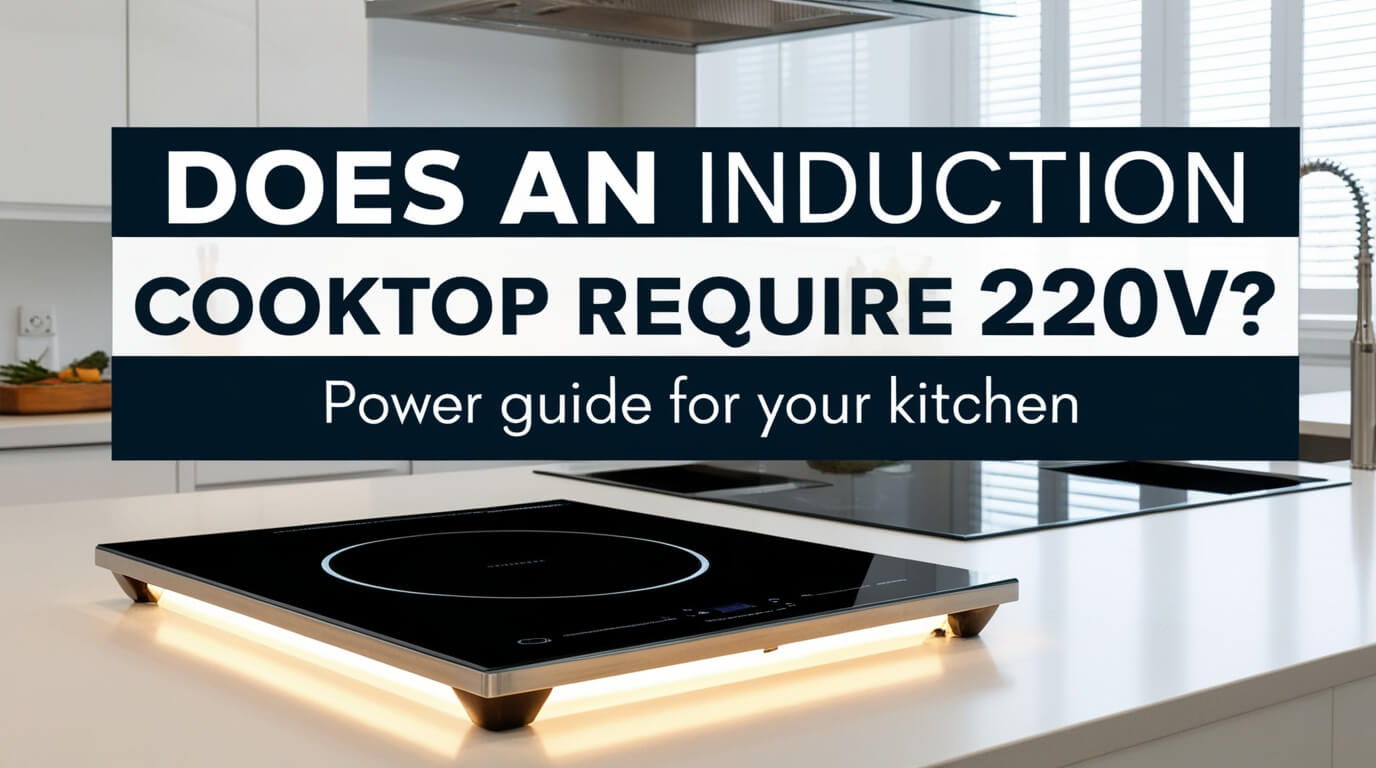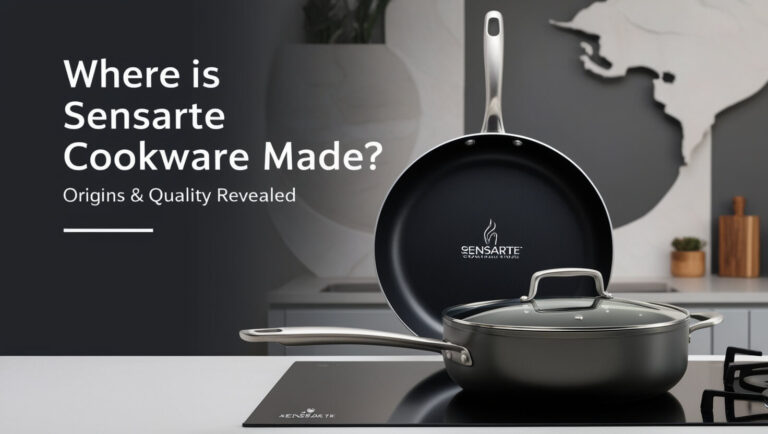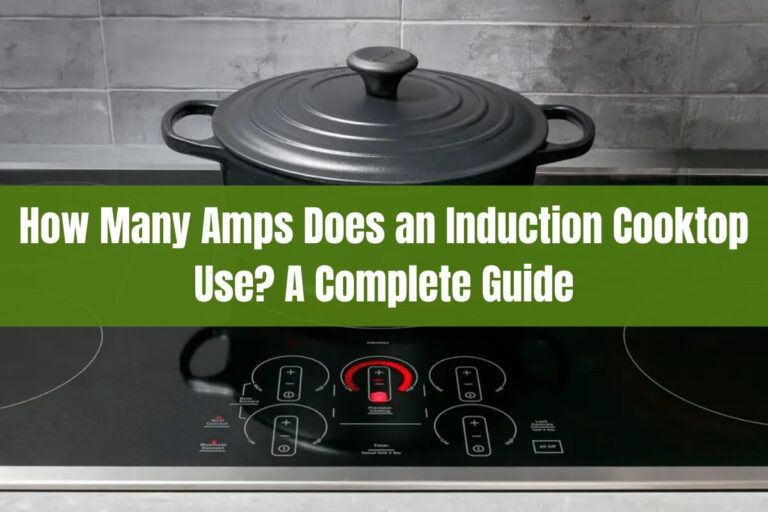
Most induction cooktops need 220-240 volts to operate at full power. This high-voltage requirement ensures optimal performance and efficiency. However, some portable models can work with standard 110-120 volt outlets.
In this guide, we’ll explore the power needs of induction cooktops, their benefits, and what you need to know before making the switch. We’ll cover everything from electrical requirements to cookware compatibility, helping you decide if a 220V induction cooktop is right for your kitchen.
What Is an Induction Cooktop?
Induction cooktops are the cutting edge of kitchen technology. They use electromagnetic fields to heat your pots and pans directly, rather than heating a burner that then transfers heat to your cookware.
How Induction Cooking Works
Induction cooktops have copper coils beneath their smooth surface. When you turn on the cooktop, electricity flows through these coils, creating a magnetic field. This field interacts with the iron in your cookware, generating heat.
Benefits of Induction Cooking
Induction cooking offers several advantages:
- Speed: It heats up faster than gas or electric cooktops.
- Efficiency: Less energy is wasted since only the pan gets hot.
- Safety: The cooktop surface stays relatively cool.
- Precision: You can control the temperature more accurately.
- Easy cleaning: The flat surface is a breeze to wipe down.
Understanding Voltage Requirements for Induction Cooktops
Before we dive deeper, let’s clarify some electrical basics.
220V vs 240V: What’s the Difference?
You might see both 220V and 240V mentioned when talking about induction cooktops. In practice, these terms are often used interchangeably. The actual voltage in U.S. homes can vary between 220 and 240 volts.
Do All Induction Cooktops Need 220 Volts?
Not all induction cooktops require 220 volts. The voltage requirement depends on the type and size of the cooktop.
Types of Induction Cooktops and Their Power Needs
Induction cooktops come in various forms, each with different power requirements.
Built-in Induction Cooktops
Most built-in induction cooktops need 220-240 volts. They’re designed to replace your existing cooktop and offer the full range of induction cooking benefits.
Portable Induction Cooktops
Portable induction cooktops often work with standard 110-120 volt outlets. They’re great for small spaces or as an extra cooking surface.
Induction Ranges
Induction ranges, which combine a cooktop and oven, typically require 220-240 volts. They need more power to run both the cooktop and oven functions.
Electrical Requirements for Induction Cooktops
Understanding the electrical needs of induction cooktops is crucial for safe and effective installation.
Amperage Needs for Induction Cooking
Most 220V induction cooktops need 40-50 amps. This high amperage allows them to heat quickly and maintain high temperatures across multiple cooking zones.
Circuit Breaker Considerations
You’ll need a dedicated circuit with a 40-50 amp breaker for your induction cooktop. This ensures your cooktop has enough power without overloading your electrical system.
Wiring Requirements for 220V Induction Cooktops
220V induction cooktops typically require 6 or 8 gauge wiring. Always consult a licensed electrician to ensure your wiring meets local codes and can handle the cooktop’s power needs.
Converting from Gas to Induction: Electrical Considerations
Switching from gas to induction cooking often requires electrical upgrades.
Upgrading Your Electrical Panel
If you’re moving from gas to induction, you might need to upgrade your electrical panel. Gas stoves usually only need 120 volts, while induction needs 220-240 volts.
Installing a 220V Outlet for Induction Cooking
You’ll need a new 220V outlet installed near your cooktop location. This job requires a professional electrician and can cost around $300.
Can You Use an Induction Cooktop with 110V?
Yes, you can use some induction cooktops with 110V power, but there are limitations.
Limitations of 110V Induction Cooktops
110V induction cooktops are less powerful than their 220V counterparts. They heat more slowly and may not reach as high temperatures. Most have only one or two cooking zones.
When 110V Induction Cooking Makes Sense
110V induction cooktops are great for:
- Small apartments
- RVs or boats
- Outdoor cooking areas
- Supplemental cooking surfaces
Energy Efficiency of 220V Induction Cooktops
220V induction cooktops are known for their energy efficiency.
Comparing Energy Use: 220V vs 110V Induction
220V induction cooktops are more efficient than 110V models. They convert more of their input power into heat in your cookware, wasting less energy.
Long-term Cost Savings with 220V Induction
While 220V induction cooktops cost more upfront, they can save money over time. Their efficiency means lower energy bills, and their durability can mean fewer replacements.
Installation Process for 220V Induction Cooktops
Installing a 220V induction cooktop isn’t a DIY job for most homeowners.
DIY vs Professional Installation
While handy homeowners might be tempted to install their induction cooktop, it’s best left to professionals. Incorrect installation can be dangerous and may void your warranty.
Safety Considerations When Installing Induction Cooktops
Proper installation ensures your induction cooktop operates safely. Key safety points include:
- Correct wiring
- Proper ventilation
- Adequate clearance around the cooktop
Compatibility of Cookware with Induction Cooktops
Not all cookware works with induction cooktops.
Testing Your Current Cookware for Induction Use
To check if your cookware is induction-compatible, try the magnet test. If a magnet sticks to the bottom of your pot or pan, it should work on an induction cooktop.
Investing in Induction-Compatible Cookware
If your current cookware isn’t induction-friendly, you’ll need to invest in new pots and pans. Look for cookware labeled as induction-compatible or made from magnetic materials like cast iron or magnetic stainless steel.
Induction Cooking Performance: 220V vs Lower Voltage Options
The voltage of your induction cooktop affects its cooking performance.
Cooking Speed and Temperature Control
220V induction cooktops heat faster and offer more precise temperature control than lower voltage options. This makes them ideal for tasks like searing meat or delicate sauce-making.
Multi-Zone Cooking Capabilities
220V induction cooktops often have multiple cooking zones, allowing you to cook several dishes at once. Lower voltage models typically have fewer zones.
Common Concerns About 220V Induction Cooktops
Despite their benefits, some people have concerns about 220V induction cooktops.
Safety Features of High-Voltage Induction Cooking
220V induction cooktops have several safety features:
- Automatic shut-off when no cookware is detected
- Child lock options
- Residual heat indicators
Addressing Electromagnetic Field (EMF) Concerns
Some worry about EMF exposure from induction cooktops. However, studies show that EMF levels drop off quickly with distance, and normal use doesn’t pose health risks.
Future of Induction Cooking: Innovations in Power Requirements
The world of induction cooking is constantly evolving.
Development of More Efficient Induction Technologies
Researchers are working on ways to make induction cooking even more efficient. Future cooktops might use less power while providing the same or better performance.
Potential for Standardized Voltage Requirements
As induction cooking becomes more popular, we might see efforts to standardize voltage requirements. This could make it easier for consumers to choose and install induction cooktops.
Making the Decision: Is a 220V Induction Cooktop Right for You?
Deciding whether to switch to a 220V induction cooktop depends on several factors.
Assessing Your Kitchen’s Electrical Capacity
Before choosing a 220V induction cooktop, have an electrician assess your home’s electrical system. They can tell you if upgrades are needed and estimate costs.
Weighing the Pros and Cons of 220V Induction Cooking
Pros of 220V induction cooking:
- Fast heating
- Precise temperature control
- Energy efficiency
- Easy cleaning
Cons to consider:
- Higher upfront cost
- Possible electrical upgrades needed
- Need for induction-compatible cookware
Embracing the Power of 220V Induction Cooking
220V induction cooktops offer a powerful, efficient, and precise cooking experience. While they require specific electrical setups, many cooks find the benefits worth the initial investment.
Whether you’re remodeling your kitchen or simply upgrading your cooktop, consider the advantages of 220V induction cooking. With its blend of performance, safety, and efficiency, it might just be the perfect choice for your culinary adventures.
Remember, the key to a successful switch to induction cooking is proper planning and installation. Consult with professionals to ensure your kitchen is ready for this exciting cooking technology. Happy cooking!






